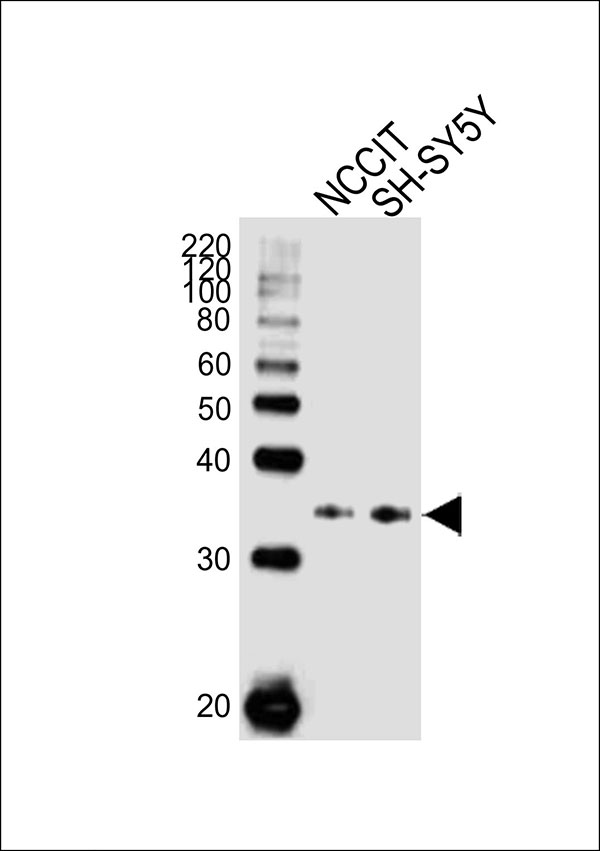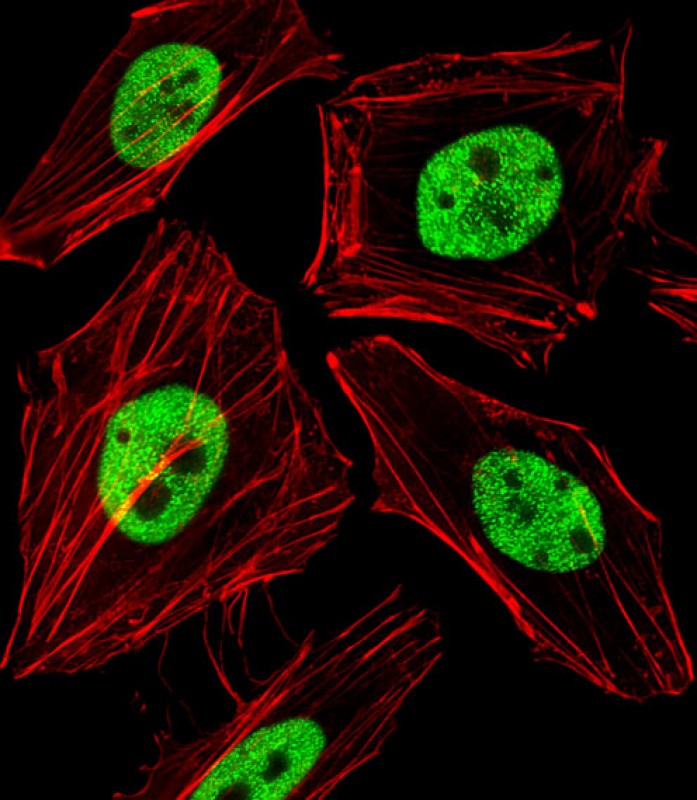WDR82 Antibody (N-term)
Purified Rabbit Polyclonal Antibody (Pab)
- 产品详情
- 实验流程
- 背景知识
Application
| IF, WB |
|---|---|
| Primary Accession | Q6UXN9 |
| Other Accession | Q8BFQ4 |
| Reactivity | Human |
| Predicted | Mouse |
| Host | Rabbit |
| Clonality | Polyclonal |
| Calculated MW | 35079 Da |
| Isotype | Rabbit IgG |
| Antigen Source | HUMAN |
| Gene ID | 80335 |
|---|---|
| Antigen Region | 12~46 aa |
| Other Names | WD repeat-containing protein 82, Protein TMEM113, Swd2, WDR82, TMEM113, WDR82A |
| Dilution | IF~~1:25 WB~~1:1000 |
| Target/Specificity | This WDR82 antibody is generated from a rabbit immunized with a KLH conjugated synthetic peptide between 12~46 amino acids from the N-terminal region of human WDR82. |
| Format | Purified polyclonal antibody supplied in PBS with 0.09% (W/V) sodium azide. This antibody is purified through a protein A column, followed by peptide affinity purification. |
| Storage | Maintain refrigerated at 2-8°C for up to 2 weeks. For long term storage store at -20°C in small aliquots to prevent freeze-thaw cycles. |
| Precautions | WDR82 Antibody (N-term) is for research use only and not for use in diagnostic or therapeutic procedures. |
| Name | WDR82 {ECO:0000303|PubMed:17998332, ECO:0000312|HGNC:HGNC:28826} |
|---|---|
| Function | Regulatory component of the SET1/COMPASS complex implicated in the tethering of this complex to transcriptional start sites of active genes (PubMed:17998332, PubMed:18838538, PubMed:20516061). Facilitates histone H3 'Lys-4' methylation (H3K4me) via recruitment of the SETD1A or SETD1B to the 'Ser-5' phosphorylated C-terminal domain (CTD) of RNA polymerase II large subunit (POLR2A) (PubMed:17998332, PubMed:18838538). Component of the PNUTS-PP1 protein phosphatase complex, a protein phosphatase 1 (PP1) complex that promotes RNA polymerase II transcription pause-release, allowing transcription elongation (PubMed:39603240, PubMed:39603239). PNUTS-PP1 also plays a role in the control of chromatin structure and cell cycle progression during the transition from mitosis into interphase (PubMed:20516061). Together with ZC3H4, but independently of the SET1 complex, part of a transcription termination checkpoint that promotes transcription termination of long non-coding RNAs (lncRNAs) (PubMed:33767452, PubMed:33913806). The transcription termination checkpoint is activated by the inefficiently spliced first exon of lncRNAs and promotes transcription termination of lncRNAs and their subsequent degradation by the exosome (PubMed:33767452). |
| Cellular Location | Nucleus. Chromosome {ECO:0000250|UniProtKB:Q8BFQ4}. Cytoplasm {ECO:0000250|UniProtKB:Q8BFQ4}. Note=Associates with chromatin (PubMed:20516061). Recruited at sites of high RNA polymerase II occupancy (By similarity). {ECO:0000250|UniProtKB:Q8BFQ4, ECO:0000269|PubMed:20516061} |
For Research Use Only. Not For Use In Diagnostic Procedures.
Provided below are standard protocols that you may find useful for product applications.
BACKGROUND
Regulatory component of the SET1 complex implicated in the tethering of this complex to transcriptional start sites of active genes. Facilitates histone H3 'Lys-4' methylation via recruitment of the SETD1A or SETD1B to the 'Ser-5' phosphorylated C-terminal domain (CTD) of RNA polymerase II large subunit (POLR2A). Component of PTW/PP1 phosphatase complex, which plays a role in the control of chromatin structure and cell cycle progression during the transition from mitosis into interphase.
REFERENCES
Clark H.F.,et al.Genome Res. 13:2265-2270(2003).
Ota T.,et al.Nat. Genet. 36:40-45(2004).
Mural R.J.,et al.Submitted (JUL-2005) to the EMBL/GenBank/DDBJ databases.
Lee J.-H.,et al.J. Biol. Chem. 280:41725-41731(2005).
Higa L.A.,et al.Nat. Cell Biol. 8:1277-1283(2006).
终于等到您。ABCEPTA(百远生物)抗体产品。
点击下方“我要评价 ”按钮提交您的反馈信息,您的反馈和评价是我们最宝贵的财富之一,
我们将在1-3个工作日内处理您的反馈信息。
如有疑问,联系:0512-88856768 tech-china@abcepta.com.























 癌症的基本特征包括细胞增殖、血管生成、迁移、凋亡逃避机制和细胞永生等。找到癌症发生过程中这些通路的关键标记物和对应的抗体用于检测至关重要。
癌症的基本特征包括细胞增殖、血管生成、迁移、凋亡逃避机制和细胞永生等。找到癌症发生过程中这些通路的关键标记物和对应的抗体用于检测至关重要。 为您推荐一个泛素化位点预测神器——泛素化分析工具,可以为您的蛋白的泛素化位点作出预测和评分。
为您推荐一个泛素化位点预测神器——泛素化分析工具,可以为您的蛋白的泛素化位点作出预测和评分。 细胞自噬受体图形绘图工具为你的蛋白的细胞受体结合位点作出预测和评分,识别结合到自噬通路中的蛋白是非常重要的,便于让我们理解自噬在正常生理、病理过程中的作用,如发育、细胞分化、神经退化性疾病、压力条件下、感染和癌症。
细胞自噬受体图形绘图工具为你的蛋白的细胞受体结合位点作出预测和评分,识别结合到自噬通路中的蛋白是非常重要的,便于让我们理解自噬在正常生理、病理过程中的作用,如发育、细胞分化、神经退化性疾病、压力条件下、感染和癌症。







